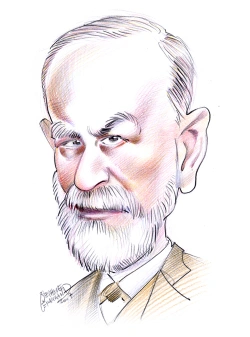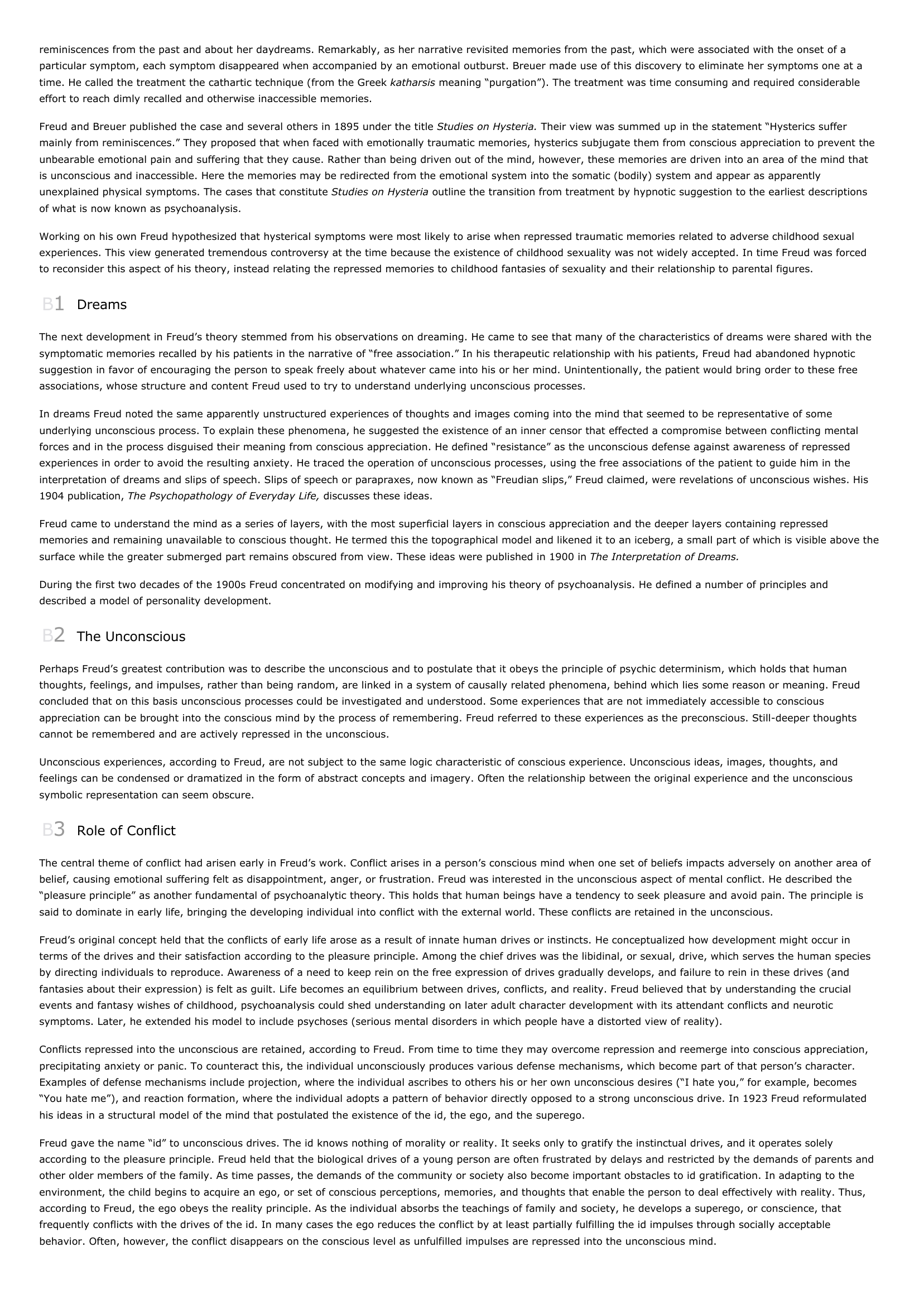Sigmund Freud.
Publié le 10/05/2013

Extrait du document


«
reminiscences from the past and about her daydreams.
Remarkably, as her narrative revisited memories from the past, which were associated with the onset of aparticular symptom, each symptom disappeared when accompanied by an emotional outburst.
Breuer made use of this discovery to eliminate her symptoms one at atime.
He called the treatment the cathartic technique (from the Greek katharsis meaning “purgation”).
The treatment was time consuming and required considerable effort to reach dimly recalled and otherwise inaccessible memories.
Freud and Breuer published the case and several others in 1895 under the title Studies on Hysteria. Their view was summed up in the statement “Hysterics suffer mainly from reminiscences.” They proposed that when faced with emotionally traumatic memories, hysterics subjugate them from conscious appreciation to prevent theunbearable emotional pain and suffering that they cause.
Rather than being driven out of the mind, however, these memories are driven into an area of the mind thatis unconscious and inaccessible.
Here the memories may be redirected from the emotional system into the somatic (bodily) system and appear as apparentlyunexplained physical symptoms.
The cases that constitute Studies on Hysteria outline the transition from treatment by hypnotic suggestion to the earliest descriptions of what is now known as psychoanalysis.
Working on his own Freud hypothesized that hysterical symptoms were most likely to arise when repressed traumatic memories related to adverse childhood sexualexperiences.
This view generated tremendous controversy at the time because the existence of childhood sexuality was not widely accepted.
In time Freud was forcedto reconsider this aspect of his theory, instead relating the repressed memories to childhood fantasies of sexuality and their relationship to parental figures.
B1 Dreams
The next development in Freud’s theory stemmed from his observations on dreaming.
He came to see that many of the characteristics of dreams were shared with thesymptomatic memories recalled by his patients in the narrative of “free association.” In his therapeutic relationship with his patients, Freud had abandoned hypnoticsuggestion in favor of encouraging the person to speak freely about whatever came into his or her mind.
Unintentionally, the patient would bring order to these freeassociations, whose structure and content Freud used to try to understand underlying unconscious processes.
In dreams Freud noted the same apparently unstructured experiences of thoughts and images coming into the mind that seemed to be representative of someunderlying unconscious process.
To explain these phenomena, he suggested the existence of an inner censor that effected a compromise between conflicting mentalforces and in the process disguised their meaning from conscious appreciation.
He defined “resistance” as the unconscious defense against awareness of repressedexperiences in order to avoid the resulting anxiety.
He traced the operation of unconscious processes, using the free associations of the patient to guide him in theinterpretation of dreams and slips of speech.
Slips of speech or parapraxes, now known as “Freudian slips,” Freud claimed, were revelations of unconscious wishes.
His1904 publication, The Psychopathology of Everyday Life, discusses these ideas.
Freud came to understand the mind as a series of layers, with the most superficial layers in conscious appreciation and the deeper layers containing repressedmemories and remaining unavailable to conscious thought.
He termed this the topographical model and likened it to an iceberg, a small part of which is visible above thesurface while the greater submerged part remains obscured from view.
These ideas were published in 1900 in The Interpretation of Dreams.
During the first two decades of the 1900s Freud concentrated on modifying and improving his theory of psychoanalysis.
He defined a number of principles anddescribed a model of personality development.
B2 The Unconscious
Perhaps Freud’s greatest contribution was to describe the unconscious and to postulate that it obeys the principle of psychic determinism, which holds that humanthoughts, feelings, and impulses, rather than being random, are linked in a system of causally related phenomena, behind which lies some reason or meaning.
Freudconcluded that on this basis unconscious processes could be investigated and understood.
Some experiences that are not immediately accessible to consciousappreciation can be brought into the conscious mind by the process of remembering.
Freud referred to these experiences as the preconscious.
Still-deeper thoughtscannot be remembered and are actively repressed in the unconscious.
Unconscious experiences, according to Freud, are not subject to the same logic characteristic of conscious experience.
Unconscious ideas, images, thoughts, andfeelings can be condensed or dramatized in the form of abstract concepts and imagery.
Often the relationship between the original experience and the unconscioussymbolic representation can seem obscure.
B3 Role of Conflict
The central theme of conflict had arisen early in Freud’s work.
Conflict arises in a person’s conscious mind when one set of beliefs impacts adversely on another area ofbelief, causing emotional suffering felt as disappointment, anger, or frustration.
Freud was interested in the unconscious aspect of mental conflict.
He described the“pleasure principle” as another fundamental of psychoanalytic theory.
This holds that human beings have a tendency to seek pleasure and avoid pain.
The principle issaid to dominate in early life, bringing the developing individual into conflict with the external world.
These conflicts are retained in the unconscious.
Freud’s original concept held that the conflicts of early life arose as a result of innate human drives or instincts.
He conceptualized how development might occur interms of the drives and their satisfaction according to the pleasure principle.
Among the chief drives was the libidinal, or sexual, drive, which serves the human speciesby directing individuals to reproduce.
Awareness of a need to keep rein on the free expression of drives gradually develops, and failure to rein in these drives (andfantasies about their expression) is felt as guilt.
Life becomes an equilibrium between drives, conflicts, and reality.
Freud believed that by understanding the crucialevents and fantasy wishes of childhood, psychoanalysis could shed understanding on later adult character development with its attendant conflicts and neuroticsymptoms.
Later, he extended his model to include psychoses (serious mental disorders in which people have a distorted view of reality).
Conflicts repressed into the unconscious are retained, according to Freud.
From time to time they may overcome repression and reemerge into conscious appreciation,precipitating anxiety or panic.
To counteract this, the individual unconsciously produces various defense mechanisms, which become part of that person’s character.Examples of defense mechanisms include projection, where the individual ascribes to others his or her own unconscious desires (“I hate you,” for example, becomes“You hate me”), and reaction formation, where the individual adopts a pattern of behavior directly opposed to a strong unconscious drive.
In 1923 Freud reformulatedhis ideas in a structural model of the mind that postulated the existence of the id, the ego, and the superego.
Freud gave the name “id” to unconscious drives.
The id knows nothing of morality or reality.
It seeks only to gratify the instinctual drives, and it operates solelyaccording to the pleasure principle.
Freud held that the biological drives of a young person are often frustrated by delays and restricted by the demands of parents andother older members of the family.
As time passes, the demands of the community or society also become important obstacles to id gratification.
In adapting to theenvironment, the child begins to acquire an ego, or set of conscious perceptions, memories, and thoughts that enable the person to deal effectively with reality.
Thus,according to Freud, the ego obeys the reality principle.
As the individual absorbs the teachings of family and society, he develops a superego, or conscience, thatfrequently conflicts with the drives of the id.
In many cases the ego reduces the conflict by at least partially fulfilling the id impulses through socially acceptablebehavior.
Often, however, the conflict disappears on the conscious level as unfulfilled impulses are repressed into the unconscious mind..
»
↓↓↓ APERÇU DU DOCUMENT ↓↓↓
Liens utiles
- commentaire de texte sur l’extrait de Le Moi et le Ça, Sigmund Freud, 1923
- Explication de texte autour d'un extrait de l'ouvrage Le poète et l'activité de la fantaisie, de Sigmund Freud
- Texte d'étude : Sigmund Freud, Le Malaise dans la civilisation - comment la civilisation peut-elle répondre à l'agressivité ?
- COMMENTAIRE DE TEXTE Études sur l’hystérie, Josef Breuer et Sigmund Freud
- SOUVENIR D’ENFANCE DE LÉONARD DE VINCI (UN), Sigmund Freud (résumé & analyse)









